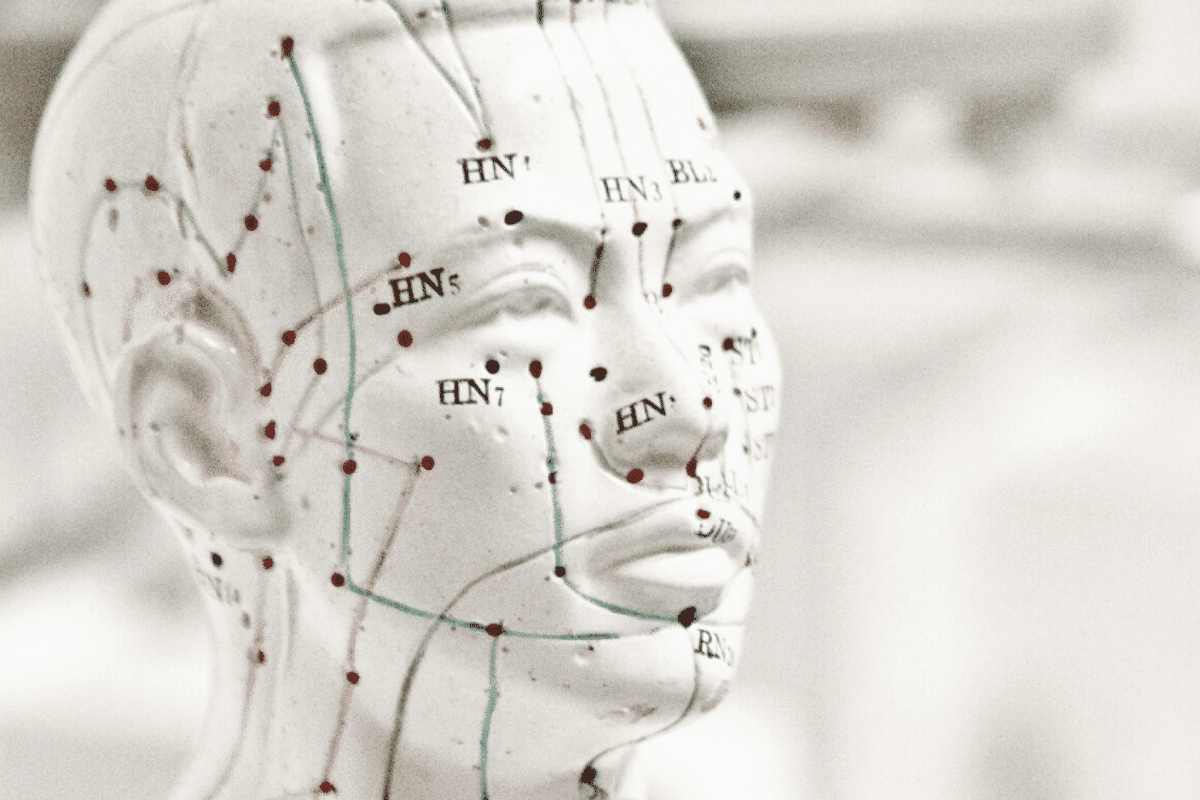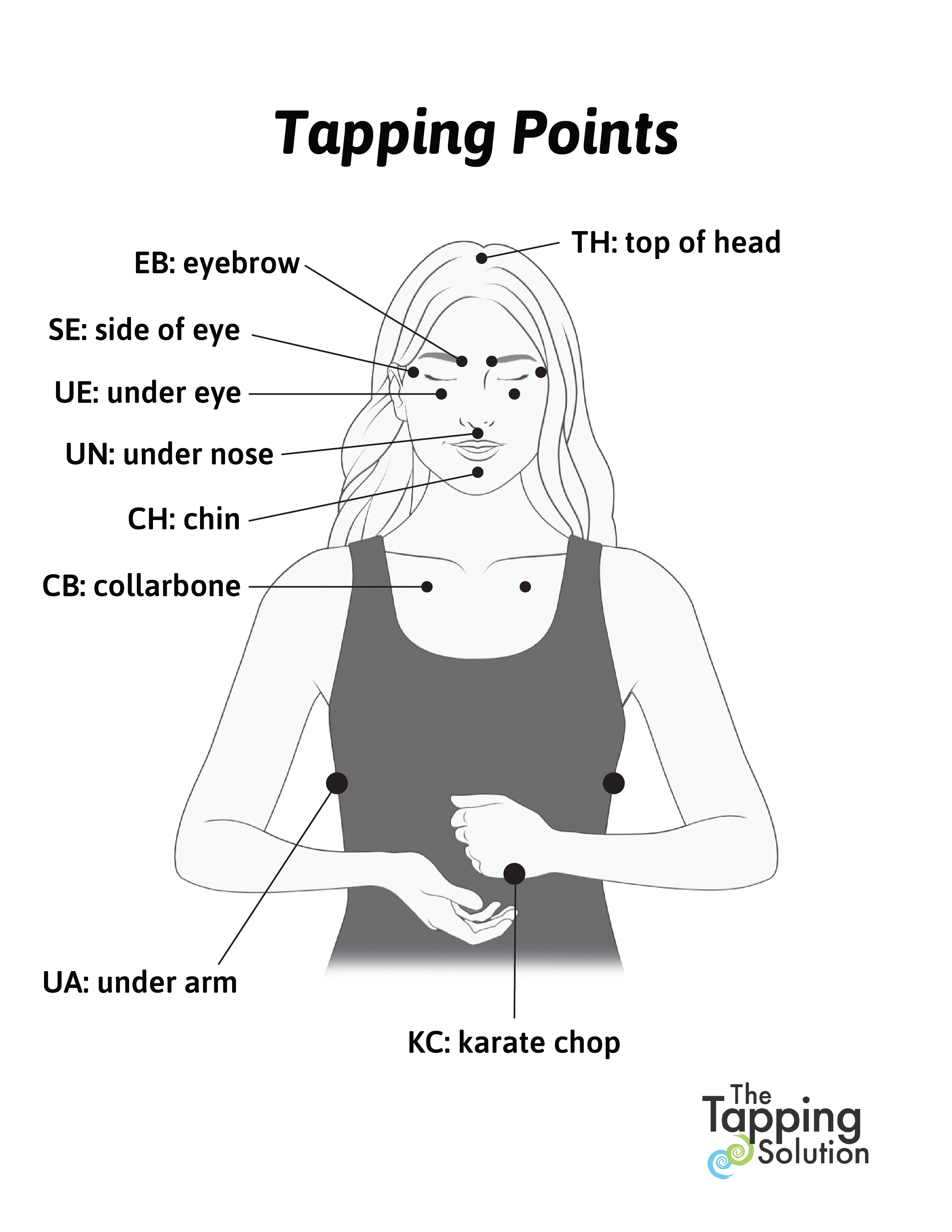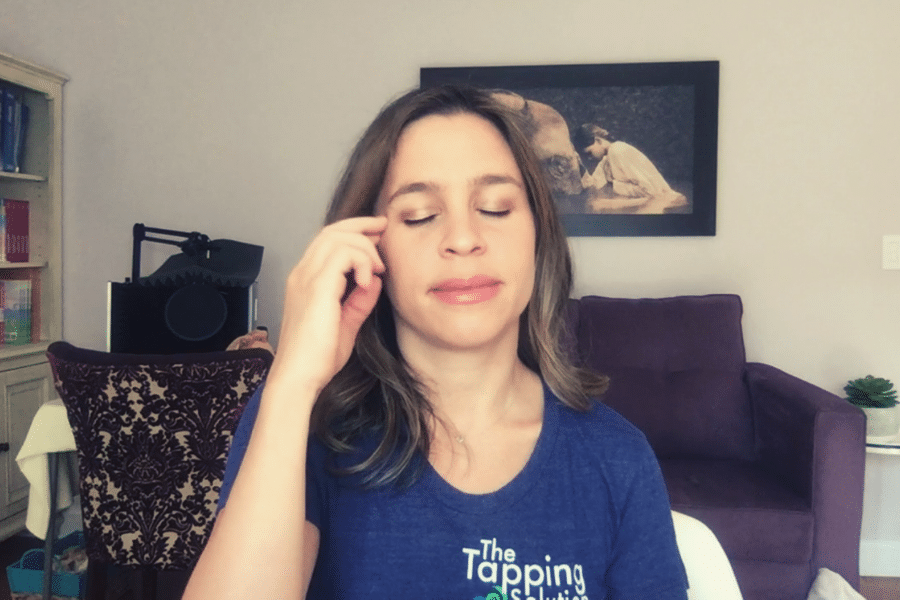If you’ve been wanting to give EFT Tapping a try but aren’t exactly sure how to go about it, you’ve come to the right place.
Tapping, which is also often called EFT (or Emotional Freedom Technique), is a healing tool that can be used to support a wide range of concerns – from daily stress and anxiety to chronic pain, fears & phobias, insomnia, and even PTSD.
We are going to break down the Tapping technique, teach you a basic Tapping sequence, and explain all you need to know about how to do EFT Tapping.
Overview of the Tapping Technique

Tapping is a simple technique that combines the principles of modern psychology and ancient Chinese acupressure. It involves using your fingertips to gently tap on a specific set of points on the body (which correspond to traditional Chinese medicine meridians), while you focus on and speak about whatever might be causing you distress or discomfort.
The act of tapping on the acupoints sends calming signals to the brain (more on this later!). So while maintaining mental focus on whatever might be causing you stress, you’re also sending a calming signal to the brain letting it know that you are safe and that it can relax. This supports you in releasing whatever is bothering you, allowing you to move forward with greater balance and ease.
Tapping can be used to support a wide range of concerns, including (but not limited to):
- General anxiety
- Daily stress
- Fears and phobias
- Depression
- Sleep problems
- Chronic pain
- Physical ailments
- PTSD
- Specific anxieties around testing, public speaking, going to the dentist, and more
How to Do EFT Tapping

Okay, it’s time to learn how to Tap!
Before we get to the sequence, let’s take a look at the Tapping points and learn some basic tips.
Here at The Tapping Solution, we use a standard set of nine EFT Tapping points for our Tapping technique, although there are other alternative points that are sometimes used for Tapping as well.
The 9 Tapping points are:
- Side of the Hand (Karate Chop): This is the fleshy, narrow side of the hand on the side of the pinky finger
- Eyebrow – On the brow bone where the eyebrows begin, closest to the bridge of the nose
- Side of the Eye – On the bone directly along the outside of either eye
- Under the Eye – On the bone directly underneath either eye
- Under the Nose – The area directly beneath the nose and above the upper lip
- Under the Mouth – This is the area just below your bottom lip and above the chin, right in the crease
- Collarbone – Starting from where your collar bones meet in the center, go down an inch and out an inch on either side
- Under the Arm – On your side, about four inches beneath the armpit
- Top of the Head – Directly on the crown of your head
Here is a diagram that may help you more easily identify the 9 Tapping points:

Beginner Tapping Tips
Before I walk you through the basic Tapping sequence, here are some important tips to keep in mind to increase your success with the Tapping technique.
Tap on either side of the body, or both at the same time.
The majority of the Tapping points exist on parallel meridians that run along both sides of the body. You can tap on either side of the body to stimulate a certain point, and you don’t have to do both sides at once (although you can if you choose to). You can also alternate sides as you go – whatever feels best.
Use a firm, but gentle pressure.
A good rule of thumb is to tap as if you were drumming on the top of your desk or testing a melon for ripeness. It should always be comfortable.
You can use all four fingers or just a few.
Do what works best for you to stimulate each point. For example, you may want to use just your index and middle fingers for the more sensitive points on the face and head. For the side of the hand, you might use all four fingers from the opposite hand, and you might even try the whole hand for the collarbone and underarm points.
Allow your intuition to lead you.
As you Tap and speak about what is bothering you, follow your gut. You don’t need to use any fancy language; simply speak your truth. And let your intuition also guide you for how long and how many rounds of Tapping feel right for you.
It doesn’t have to be perfect.
When you are starting out, the sequence might feel hard to remember. That’s okay; there’s no one way to Tap! It still works, even if it isn’t perfect. Just do your best, stick with it, and don’t get too caught up in the details.
Okay, so we’ve covered the basics of Tapping. Now it’s time to actually do it while learning how to move through the Tapping sequence. Are you ready?
The Basic Tapping Sequence: How to Tap!

Here’s your step-by-step guide to using the Tapping technique for yourself:
Step 1. Identify the problem you want to focus on
This can be general anxiety, a specific situation that you are stressed about, a physical ailment, or a fear or phobia, for example. It doesn’t matter what it is, as long as it is causing you distress or discomfort and getting in the way of you feeling your best.
Ask yourself, “What is on my mind? What am I stressed or bothered about? What is my most pressing issue right now?”
Step 2. Consider how you feel before starting
When you think about the feeling, problem, or situation, how do you feel about it right now? How intense is it for you? Rate the intensity of your distress on a scale from 0 to 10, with 0 being the lowest intensity and 10 being the highest.
Step 3. Compose a setup statement
Tapping begins with something called a “setup statement.” This statement acknowledges the problem you want to deal with. It should focus on accepting where you are and how you feel right now.
A setup statement often follows a framework that sounds something like this:
“Even though I [fill in the blank with your specific problem or feeling], I accept how I feel.”
There are a lot of different ways to compose a setup statement. Here are a few examples:
“Even though I feel this anxiety, I accept how I feel.”
“Even though I am nervous about this presentation, I love and accept myself.”
“Even though I have this back pain, I honor my feelings and give myself permission to relax.”
This setup statement helps you neutralize any judgment you may have about the problem and sets you up for the rest of the process.
Step 4. Repeat the setup statement three times while Tapping on the side of the hand
Take a deep breath in, and then out. Now it’s time to start Tapping!
Gently tap your fingertips on the Side of the Hand (the Karate Chop Point) using your opposite hand. Continue Tapping on the Karate Chop point as you repeat your setup statement (either out loud or in your mind) three times over.
Step 5. Follow the Tapping sequence through the remaining Tapping points
Next, you will move through the remaining eight Tapping points starting at the Eyebrow and ending at the Top of the Head.
Eyebrow → Side of the Eye → Under the Eye → Under the Nose → Under the Mouth → Collarbone → Under the Arm → Top of the Head
A good rule of thumb is to tap about 5-7 times on each Tapping point before moving on to the next point, but you can do whatever feels right for you.
As you tap through each of the points, simply say how you feel – being honest with yourself and acknowledging where you are emotionally. You can do this in your mind, or out loud.
Tips:
- It can be helpful to think about this as giving voice to the recording in your head, which you are likely already playing round and round.
- You can imagine calling up a friend to vent about the problem and telling them about how you are feeling.
- For the example about giving a presentation, you might say things like, “I’m so nervous about this presentation… I’m worried about being in front of so many people… I feel so much pressure to perform… What if I do poorly?… I don’t want to embarrass myself… This pressure and anxiety are overwhelming…”
- You can also try the Tapping method of coming up with a simple reminder phrase that you repeat as you tap through the points. It can be something basic like, “my anxiety” or “my nerves about the presentation.”
This part of the process allows your brain to understand that even though you are feeling this stress, anxiety, or other difficult emotion, you are still safe.
One initial aversion to this process is that you may feel like you’re “anchoring in” the negative. But I like to refer to it more as speaking the truth about how you’re feeling, since you’re already likely repeating these thoughts in your head all day long already. 😉
Step 6. Assess how you feel now
Once you tap through each of those eight points as described above, you have completed a round of Tapping. Nice work! Now, it’s time to assess how you feel.
Think about the problem again. How intense is your experience now? Give the intensity a rating on the same 0 to 10 scale as before. Have you noticed any shift compared to a few minutes ago before you began Tapping?
If the intensity is still higher than you’d like, that’s okay. You can continue to Tap until you feel better.
Step 7. Do additional rounds of Tapping as needed
If the intensity of your feelings is still higher than you’d like, keep Tapping. Go back to Step 3 and proceed through the steps of the Tapping sequence again. Continue working your way through the Tapping points in sequence, doing additional rounds of Tapping as needed until you feel better.
As you go through the rounds, you can adjust your setup statement slightly to account for any change or progress you might feel.
Step 8. Move towards the positive with a final round of Tapping
Now that you’ve focused on releasing the issue and your emotions around it, you can work on instilling some positive feelings in its place.
Imagine this like a garden. Before you plant any new seeds, you have to get rid of the weeds. With Tapping, we use the initial rounds to release the intensity of what we are feeling so we can feel better. And then from there, we can allow the positive to begin to take root.
For this final step of the Tapping technique, you will move through the Tapping sequence as you did earlier (starting at the Eyebrow and ending at the Top of the Head). This time, however, as you Tap through the points you will think or speak phrases that help you feel empowered and positive as you move forward.
Examples could include:
“I am feeling calm and confident.”
“I am becoming more relaxed and joyful.”
“Feeling relaxed and at ease…”
“I have faith in my ability to change.”
“I am prepared and ready for ___.”
“This is my time.”
“All is well.”
“I am safe.”
Step 9. Celebrate!
You’ve just completed your first Tapping session. You now know how to Tap! Way to go!
This is a process you can repeat any time you need to release stress, find relief from discomfort, and center yourself so that you can move forward with your day from a place of greater ease, balance, and calm.
How Does Tapping Work?

So now that you have a better idea of what this whole Tapping thing involves, you might be wondering how it works and how it can help you to feel better.
The act of physically tapping along the meridians at the nine Tapping points sends calming signals to the amygdala – the part of your brain that controls the stress response.
The amygdala helps us to stay safe in dangerous situations, kicking our fight-or-flight response into action so that we can prepare to either flee from danger or fight it.
In modern times, we tend to have our amygdala in charge way too often. The stress response is activated in everyday situations, putting us into fight-or-flight mode even when we are in no real danger. This might happen when we are feeling pressure over a work deadline, nervous about a presentation, or frustrated over a physical ailment, for example.
It might have been helpful for our ancestors when facing a bear in the woods, but nowadays this survival instinct can do more harm than good.
Calming the stress response
I like to think of Tapping as a way to send your mind’s prehistoric programming back into extinction. When we Tap, it sends calming signals to the amygdala letting it know that we are actually safe – that it can relax and deactivate. Tapping actually alters the stress response – even lowering the stress hormone cortisol.[1,2]
We can use Tapping to help us rewire the brain and reprogram the patterns that keep us stuck. Ultimately, this allows us to let go of the stress, anxiety, frustration, and overwhelm that so often get in the way, making room for greater ease, calm, and centeredness as we move forward.
And if you are wondering, “Does Tapping really work?” Yes! Just check out this article to learn all about the scientific research behind this evidence-based approach.
I’ve seen Tapping transform the lives of so many people. And I can’t wait to see what it can do for you, too!
Head to The Tapping Solution App to Learn How to Do EFT Tapping!
By following the Tapping sequence above and putting the Tapping technique into practice, you are well on your way to learning how to do EFT Tapping like a pro.
If you are someone who prefers to be guided through the process in real-time, without having to think too much about what to do or what to say, then I highly encourage you to check out The Tapping Solution App.
In the app, you’ll find a huge library of guided Tapping Meditations (including free ones) that will walk you through the process of how to use Tapping and provide support for a wide range of different concerns.
Our guided session, Intro to Tapping and the App is a great place to start.
Until next time…
Keep Tapping!
Nick Ortner
Are you new to Tapping? How did you find out about it? Comment below!
References
- Church D, Yount G, Brooks AJ. The effect of emotional freedom techniques on stress biochemistry: a randomized controlled trial. J Nerv Ment Dis. 2012;200(10):891-896.
- Stapleton P, Crighton G, Sabot D, O’Neill HM. Reexamining the effect of emotional freedom techniques on stress biochemistry: A randomized controlled trial. Psychol Trauma. 2020;12(8):869-877.











Connect With Us on Social Media